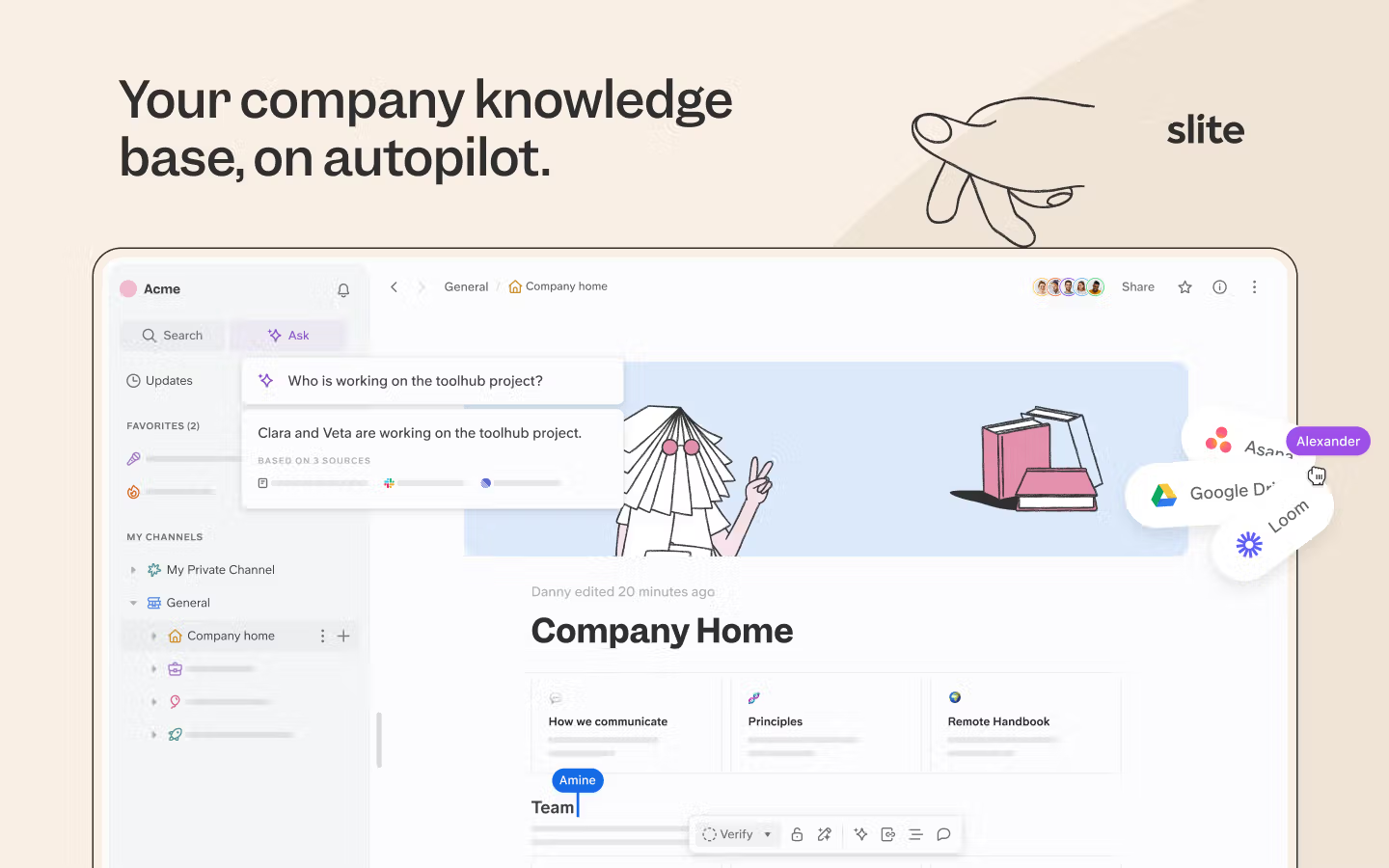You know how frustrating it is when you can’t find something on your company’s intranet. It means writing another message requesting for links, or worse, writing an email to a senior to re-request information that’s been previously shared.
This guide is all about why the solution to the re-asking loop: The Intranet Search Engine. We’ll show you some simple ways to make your intranet search work better, so you and your team can find what you need, when you need it. Unlike enterprise search systems, which use sophisticated technology to index information across various platforms and databases, intranet search engines are designed specifically for internal networks, providing access to company news, HR documents, and collaboration tools.
What’s an Intranet Search Engine?
An Intranet Search Engine helps you search for files, info, and everything else within your company intranet. A company’s intranet is a contained ecosystem, teeming with specific company information you deem important. An intranet search engine helps you search it one go. With precision and relevance finely tuned to the corporate environment, these engines transform the search experience, bringing up company news, collaborative project details, and resources crucial for task completion. Understanding how employees search for content is essential to improve the intranet search solution and provide the most helpful information at the time of the search.
The Upside of Intranet Search Engines
Intranet search is about more than just finding files - it’s a powerful tool for boosting employee engagement. When employees can easily access the information they need, it leads to a measurable impact on productivity and morale.
Why such a big difference? A well-designed intranet search function eliminates wasted time searching for information, freeing employees to focus on their tasks. On average, employees spend several hours each week searching for information. This sense of efficiency contributes to a more positive work environment and increased job satisfaction, ultimately enhancing employee satisfaction.
Furthermore, integrating your intranet search with communication and collaboration tools fosters a greater sense of connection within the organization. Imagine an employee directory that’s not just a list of names, but a dynamic hub where employees can connect with colleagues based on shared projects, skills, or interests.
Finally, personalization is key. By tailoring the intranet experience to individual employee roles, languages, and interests, you create a more relevant and engaging digital workplace. This level of personalization leads to increased adoption and usage of the intranet, further maximizing its value as an engagement tool.
The Downside of Intranet Search Engines
While intranet search engines hold immense potential for boosting productivity and engagement, several common challenges can hinder their effectiveness. Let’s explore these roadblocks and, more importantly, how to overcome them:
Ensuring secure search functionality is crucial for maintaining data security and compliance across multiple platforms.
1. Information Overload and Siloed Data
- The Challenge: Organizations often struggle with an overwhelming volume of digital content scattered across various platforms, departments, and systems. This creates data silos, making it difficult for employees to find what they need, even with a search bar.
- The Solution: Implement a robust content management strategy that includes:
- Centralized Content Repositories: Consolidate information into a well-structured intranet with clear categories and metadata tagging.
- Data Integration: Connect your intranet search to other critical systems (CRM, ERP, etc.) to break down silos and provide a unified search experience.
2. Outdated or Poorly Maintained Content:
- The Challenge: Outdated or irrelevant search results erode trust and lead to wasted time. Employees might give up on the intranet entirely if they consistently encounter dead ends.
- The Solution: Establish a content governance process that includes:
- Regular Content Audits: Periodically review and update content, removing outdated information and ensuring accuracy.
- Content Ownership: Assign clear ownership for different content areas to ensure accountability for updates and maintenance.
3. Lack of User-Friendly Design and Features:
- The Challenge: A clunky, unintuitive search interface can be a major deterrent. Employees are less likely to use a search engine that's difficult to navigate or doesn't provide helpful results.
- The Solution: Prioritize user experience by:
- Intuitive Search Interface: Implement features like autocomplete, faceted search, and query suggestions to guide users.
- Mobile Optimization: Ensure your intranet search is fully responsive and accessible across all devices.
- Personalized Results: Tailor search results based on user roles, departments, or past search history to deliver greater relevance.
4. Inadequate Search Engine Technology
- The Challenge: Basic keyword-based search engines often fail to understand the context or intent behind user queries, leading to irrelevant or incomplete results.
- The Solution: Invest in modern search technologies, such as:
- Natural Language Processing (NLP): Enables users to search using everyday language and receive more accurate results.
- Machine Learning (ML): Continuously learns from user behavior and search patterns to improve result relevance over time.
How is Intranet Search different from Enterprise Search?
Intranet search is a focused tool for navigating your company’s internal website. Enterprise search is designed to break down data silos, connect all your apps and tools like Slack, MS Teams, Google Drive across the entire organization. In addition, intranet search engines can streamline project management by centralizing resources and tasks, improving collaboration, and ensuring that everyone in the business is on the same page.
Intranet Search
- Focus: Primarily designed for accessing information within a company's intranet. This includes internal documents, policies, procedures, company news, employee directories, and other resources specific to the organization.
- Scope: Limited to the intranet environment. It typically doesn't index or search external websites, cloud storage, or personal devices.
- Audience: Primarily employees and authorized internal users.
- Features: Often integrated with other intranet tools and applications, emphasizing a user-friendly interface and personalized experiences.
Enterprise Search
- Focus: Aims to provide a unified search experience across all data sources within an organization, regardless of location or format. This includes intranets, databases, cloud storage, shared drives, CRM systems, and even external websites.
- Scope: Much broader than intranet search, encompassing a wide range of data sources, both structured and unstructured.
- Audience: Can be used by employees, management, IT teams, and potentially even customers or partners (depending on configuration).
- Features: Often includes advanced search capabilities like federated search, natural language processing, and data analytics to deliver more relevant results and insights.
Can you get the best of Enterprise and Intranet Search in one tool?
You might be thinking, "Do I need to choose between a focused intranet search and a comprehensive enterprise solution?" The good news is: you don't have to.
The ideal scenario is a single platform that combines the user-friendliness and targeted focus of an intranet search with the power and reach of enterprise-grade capabilities. This is where a knowledge base solution like Slite comes in.

Slite: Your Centralized Knowledge Hub with AI-Powered Search
Slite goes beyond traditional intranet search by offering:
- A Unified Knowledge Base: Consolidate all your important information—from company policies and project documentation to meeting notes and team wikis—into a single, easily searchable platform.
- AI-Powered Search (Ask): Slite's advanced search functionality, powered by AI, understands natural language and context. This means you can ask questions like "What's the latest marketing campaign plan?" or "Find the meeting notes on customer onboarding" and get accurate, relevant results.

- Seamless Collaboration: Slite is built for teams. Collaborate on documents in real-time, add comments and mentions, and keep everyone in the loop with activity feeds and notifications.
- Easy Organization and Access: Structure your knowledge base with intuitive folders, channels, and tags. This ensures that information is easy to find and navigate, whether you're searching for something specific or browsing for inspiration.
- No-BS verification features: Slite's Knowledge Management Panel shows you the health of your company information. With it, you can easily update/archive/re-verify 100s of docs - at once.

With Slite, you don't have to compromise. You get the best of both worlds—a user-friendly platform that empowers your team to find the information they need quickly, while also providing the robust search and knowledge management capabilities of a comprehensive enterprise solution.
Super
The second product by Slite, Super connects to all your internal tools (Slack, Notion, Google Drive, Intercom, JIRA, Hubspot, and more) and transforms scattered company knowledge into an intelligent search experience.
Unlike traditional intranet search:
- Super indexes up to 10,000 pages from selected sources automatically
- Respects original permissions so users only see content they have access to
- Provides factual information without hallucination
- Allows filtering AI search results to specific spaces or contexts
- Accessible from anywhere you work through the Chrome Extension
Companies like Wuffes have already transformed how their teams find and use internal knowledge with Super's AI-powered search capabilities.
Need More Help Understanding All This?
It’s hard to pick the right tool that matches compliance, pricing, and features. Care for a chat? If you'd like to explore how Slite can help you streamline knowledge sharing, boost productivity, and create a more engaged workforce, we're here to help! Book a demo here or learn more about our features here.

